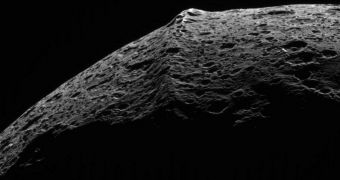One of the most interesting bodies in the solar system is Iapetus, one of Saturn's moons. Its main feature is a 20-kilometer (12.4-mile) high ridge that spans the length of its Equator, and which managed to defy explanation until now. A new study proposes an interesting hypothesis for how it came to be.
What is weird about this ridge is that there is no way of explaining it through known geological phenomena. If certain processes led to its formation, then it's safe to assume that similar structures would have been found on other celestial bodies as well. That was not the case.
As such, this implies that whatever process led to the formation of the high ridge was characteristic to Iapetus alone. The moon looks like an over-sized walnut because of it.
Observations of the Saturnine satellite revealed that the tall ridge encircles as much as 75 percent of its Equator, and has a width of around 200 kilometers (124 miles). The structure makes up about one thousandth of the moon's mass.
All explanations that were developed to explain this weird occurrence failed, largely because they sought to provide a series of answers about the ridge using conventional geological processes.
But University of Illinois in Chicago (UI) planetary scientist Andrew Dombard believes that explaining Iapetus' appearance may require the introduction of another moon into play. The expert was the lead author of a study appearing in the March 7 online issue of Journal of Geophysical Research-Planets.
“I would love to stand at the base of this wall of ice 20 kilometers tall that heads off straight in either direction until it dips below the horizon,” Dombard explains, as quoted by Space.
The theory he developed holds that an important space impactor collided into Iapetus billions of years ago, removing a large amount of debris from the object, and leading to the formation of a sub-satellite in orbit around the moon.
In time, the gravitational pull of Iapetus ripped its moon apart, breaking it off into little chunks. This debris then began to rain down on the small world, contributing to forming the ridge within centuries.
Unlike other moons in the solar system, Iapetus may have held on to such a companion due to its unusual orbit, which is very distant from Saturn's surface. This prevented the gas giant from literally stealing its moon's moon.
The new hypothesis is definitely interesting, so the research team says that it will continue investigating this possibility in detail.

 14 DAY TRIAL //
14 DAY TRIAL //